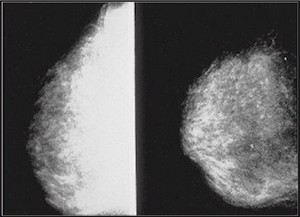Almost daily women are reminded by doctors, media, and other sources to do regular self-breast exams to look for breast lumps, but very rarely are women told about breast calcifications.
These calcifications, which can be seen on a mammogram as white spots of varying shapes and sizes, can be indicative of increased breast activity in certain cells. More active cells take in more calcium. This is not, however, related to the calcium intake from diet or from supplements.
There are two types of calcifications. Macrocalcifications usually indicate changes in the breast from aging, old injuries, or inflammations. Most macrocalcifications are in no way related to cancer. Their cause may be calcium deposits in cysts or milk ducts. They appear in mammograms as large white dots or dashes. In the United States, these calcifications show up in about half of women over age 50. They show up in 10 percent of women under 50.
Microcalcifications show up on a mammogram as tiny white specks. This is the term sometimes used to refer to calcifications that are found with malignancy. These calcifications are generally smaller and more numerous, while calcifications associated with benign conditions are usually larger, and fewer in number. Microcalcifications are not generally due to cancer, but a group of them in a small area might possibly indicate pre-cancerous changes in the breast.
If suspicious calcifications are spotted on a mammogram, a radiologist might suggest a needle biopsy. If macrocalcifications are detected, the doctor will probably suggest coming back for a follow-up mammogram within one to two years, since they are generally considered harmless.
A needle biopsy is usually done under a local anesthetic using ultrasound imaging to guide the doctor to the spot where the calcifications are located. In the rare instance that the needle biopsy is unsuccessful in getting enough of the calcification the doctor may perform a surgical excision of the spot to ensure that enough of the calcification is removed to obtain a clear test result.
You may want to ask your doctor some questions if your mammogram reveals that you have breast calcifications. Ask exactly what the results of the mammogram indicate and which types of calcifications are shown, micro or macro. You should also ask if there is an indication of a pre-cancerous condition or a malignancy and ask your physician if we would recommend a biopsy. The most important thing you need to know is when another mammogram should be taken. Make your appointment with the mammography clinic right then so that you don’t forget to have a follow up.
Breast health is of vital importance to all women. Make sure that a breast self-exam is performed once a month. See your doctor for a yearly breast exam and have mammograms as recommended by your physician.
This year 178,480 women in the United States will be diagnosed with breast cancer. 40,460 women will die from breast cancer. Taking a few small steps can help to ensure that you are not one of them.
